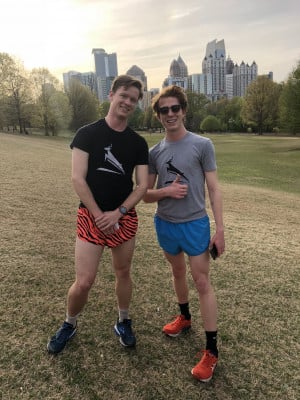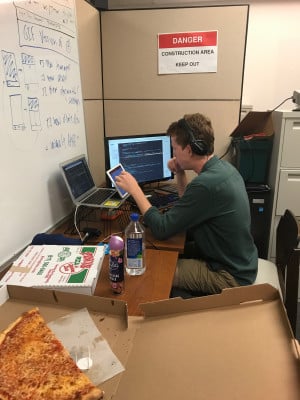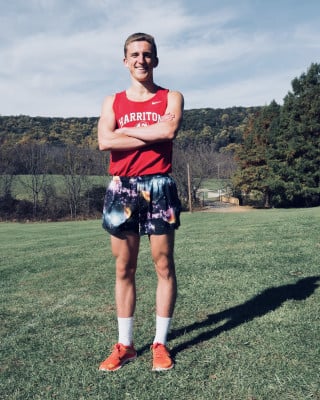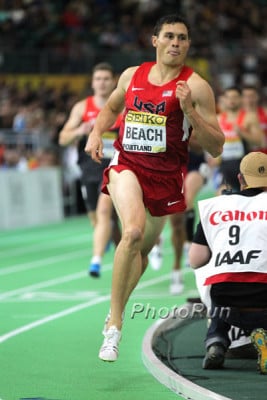Willamette Valley Meets Silicon Valley: Three Running “Startups” Are Trying to Revolutionize the Stopwatch
By Jonathan Gault
July 26, 2018
2022 update: In the years since this article was published, Trackster, like many startups, has pivoted its focus. It has gone from a prototype stopwatch app to a full training platform, allowing athletes to sync Trackster with their GPS training devices and receive coaching tips from athletes such as Des Linden and Matthew Centrowitz. The stopwatch feature has been removed from the app.
***
It’s a good thing Jack Sexton was wearing a Boston College shirt.
It was June 2017, and Sexton, on summer break from BC, was in Clovis, Calif., for the California state track meet. He was there to pitch Trackster, the nascent stopwatch app he had launched with another BC student, Emmett Scully, when he spotted Andy Powell, then the men’s distance coach at the University of Oregon. While Oregon is a track & field powerhouse, Powell was an unlikely target.
“I’m not big into technology or anything like that,” Powell says. “Probably, I’m anti-technology.”
But Powell, a Massachusetts native whose high school 5K course record at fabled Franklin Park will turn 20 years old this fall, has a soft spot for his home state.
“Anytime I see anyone with anything Boston on, I get excited,” Powell says.
So he got to talking with Sexton, who told him about Trackster. Powell was so intrigued that he met with Sexton again the following day for around five hours, offering suggestions and ways to improve the app. Eventually, with Powell’s encouragement, his Oregon runners all began logging their workouts on Trackster. So did recent alums Edward Cheserek and Parker Stinson. After graduating BC this spring, Sexton and Scully decided to take a risk: armed with $40,000 in funding ($20,000 from the venture group Dorm Room Fund, $8,000 from an app competition at BC, and $12,000 from friends and family) they would move to Eugene, Ore., and try to see how far they could take Trackster.
The Willamette Valley isn’t quite Silicon Valley, and with Powell, newly hired as the head coach at the University of Washington, now in Seattle, Sexton and Scully may not stay in Eugene beyond this summer. But for now, Trackster’s home address is a two-bedroom Airbnb on Villard Street, just a few blocks away from Hayward Field — or what’s left of it.
“If you want to be an actor, go to Hollywood,” Scully says. “If you want to be in running, go to Eugene.”
***
Sexton, 21, and Scully, 22, met as college teammates at Boston College. Sexton, who graduated in three years and holds a degree from BC’s Carroll School of Management, handles the business side while Scully, a computer science major, is in charge of the app’s design and development. But it wasn’t until the start of 2017, at which point both men had left the team (Scully was cut after his sophomore spring; Sexton left after his sophomore fall) that they really started grinding on Trackster.
One frustration that Sexton and Scully shared from their time on the BC team centered around workouts. They’d show up to an interval session not sure what to expect. Their coach wasn’t one for keeping records, either; once the team finished a workout, their splits vanished unless the athletes timed each rep themselves and transferred the data to their running logs.
Sexton and Scully figured there might be an easier way to do it. Scully had some programming experience, but not a lot.
“I studied biology at Boston College for, like, a year and a half and then I kind of thought, Oh, there might be an app I want to make, I bet it’s not that hard,” Scully says. “And then I started and I was like, Okay, it’s really hard but I’m kind of into it. And [I] just started going from there.”
Initially, Sexton and Scully considered using radio-frequency identification (RFID) — the technology marathons use to track runners — but that proved too expensive and would involve developing hardware — “and hardware was just not the game that we were super interested in,” Scully says.
Their next idea was to take a picture of athletes as they finished a rep; the app would recognize each athlete’s face and assign the proper split to each athlete’s profile. That was what Trackster did when it was first released on the App Store a year ago, and though the technology ultimately proved too complicated, Sexton and Scully liked the idea of athlete profiles, which led to the current iteration of the app.
Here’s how Trackster works. Press the iPhone’s volume down button to start the stopwatch. Press volume up to record a split; do this for as many athletes as you want, and when the final athlete has finished, press volume down to end the rep. Repeat as necessary for as many reps as the workout requires.
For a single athlete, a traditional sport watch on the wrist is certainly easier. But Trackster wasn’t designed for a single athlete — it was meant for coaches and teams (it was Powell’s idea to utilize the volume buttons to mimic the feel of a traditional stopwatch). And that’s where the app shines. Every split from every workout can be assigned to a specific athlete (as long as they’re on the app as well), which means that an athlete can view his entire workout on the app by the time he’s finished his cooldown.
Powell still maintains handwritten logs on paper as well, but says he likes the ability to quickly share workout results with his entire team on a platform that all of them can access.
Trackster also boasts the ability to have multiple stopwatches running at the same time. Users can easily toggle between them during a workout, which allows a coach to keep track of the 800 group, the mile group, and the 5k group all on the same device. That is a problem coaches have been grappling with for some time — American Distance Project coach Scott Simmons developed a multiple-stopwatch app for the PalmPilot back in 2004, though with the decline of the PalmPilot, Simmons says “it’s not relevant today.”
The ability to start multiple stopwatches on one device was a big selling point for Powell, who would often have three or four groups working out simultaneously. To keep track of every split, Powell would either have to delegate to his assistants (last fall, that sometimes included a certain Matthew Centrowitz, who served as volunteer coach at his alma mater and will take on the same role at UW) or scramble around practice to catch up with splits he may have missed.
“As the workouts go, I would get the results and I would try to write things down, a lot of times I’d have to go to the athletes — because they time it too –and I’d be like, ‘Hey, do you remember what you had for that third interval?'” Powell says.
Trackster’s stopwatch has a companion app, integrated with the stopwatch, that serves as a more traditional running log. That app also features a social media feed that allows runners to view workouts from athletes that they follow, such as Cheserek, whose log contains all of his training from his incredible 2018 indoor season. One highlight: 10 days before his 3:49 indoor mile in Boston, Cheserek ran 3 x mile (5:01, 4:50, 4:45), followed by 9 x 400 (62, 61, 60, 59, 58, 58, 57, 55, 49) and 1 x 200 (27) at altitude in Flagstaff.
Unlike Strava, Trackster does not yet have the ability to upload Garmin data to the app, but Sexton and Scully say that they are hoping to change that down the road.
Sexton says that, as of the first week of July, Trackster had over 2,700 users. That includes 30 to 40 active high school or college teams, including UCLA, Colorado, Virginia, William & Mary and, now that Powell is there, Washington. Sexton and Scully are in Eugene until the middle of August — though they’ve also made some trips to Boulder to shoot promotional videos with Stinson — but aren’t sure where they’ll be based beyond then; they may follow Powell, whom they still speak with once a week, to Seattle, or return home to Boston.
While Trackster’s early progress is impressive, both Sexton and Scully admit that they’re still learning as they go. Sexton had four internships with Cisco but notes that “internships on a big company isn’t wildly applicable to a startup.” Scully’s previous jobs include stints at a pizza place and the zoo, and as for the coding…
“I wouldn’t even say I’ve gotten good at coding yet,” the former biology major Scully says with a laugh. “[But the app] works.”
Sexton realizes that an app geared toward track teams doesn’t have the mass appeal of an app like Uber, but is excited where Trackster is headed.
“We’re not chasing a billion-dollar company. We’re kind of chasing something we think is good for the niche running market,” Sexton says, before he corrects himself. “Some people view running as niche. We don’t view it that way, but plenty of people do.”
***
The more users Trackster gets, the more suggestions Sexton and Scully hear about ways to improve the app. It takes discipline to know which ones to act on.
“That’s probably the hardest part because you want to go back to everyone with, ‘You know, we just did this because you said it, don’t you like us now?’” Scully says. “But then also sometimes that just doesn’t make sense for what we’re doing at this moment.”
And then there’s the challenge most startups inevitably face: finding a way to make their idea profitable. Right now, Trackster is free to download and use, and Sexton and Scully plan to keep it that way for the foreseeable future. But they have ideas to monetize the app. The main one centers around offering training plans designed by pro athletes using the app, such as Cheserek and Stinson; they’re also considering putting some of the pro athletes’ logs behind a paywall. In both cases Sexton says, the majority of the fees Trackster charges — 80 to 90% — would go to the athlete, with Trackster pocketing the remainder. They’ve also considered incorporating ads, perhaps from shoe companies who would be able to target a user who has put a lot of miles on a certain shoe and is due for a replacement.
There’s also the matter of competition. Right now, Sexton says that Trackster’s #1 competitor remains “a digital stopwatch and a piece of paper.” But there are other developers exploring the same territory.
***
Shortly after graduating from Harriton (Penn.) High School this spring, 18-year-old Derek Goss, released his own stopwatch app, Synchro Stopwatch, which hit the App Store on June 24. Goss, who will attend Cornell University in the fall, says the app was downloaded over 200 times in its first two weeks. Goss, like Sexton and Scully, wanted to create an easy way to save and share workout times for a group of athletes, and while Synchro does that, it also has the ability for users to share live stopwatches with other users while a race or workout is ongoing — something Goss thought might be helpful while running the Philadelphia Half Marathon last year. Goss’ friend’s father was at the halfway mark of the course, and Goss was hoping to get a split from him, but realized his friend’s father wouldn’t know exactly when to start his watch.
“I was thinking [it was a problem] if you had somebody like that who was trying to time you, but they weren’t going to be at the beginning of the race to time you,” Goss says.
Like Trackster, Synchro users can have multiple stopwatches running at once (you can start them using the volume buttons or the touchscreen), but to use more than two at a time, you must upgrade to the paid version of the app, which costs $8.99.
Goss, who plans to study engineering and join the club running team at Cornell, doesn’t have nearly as much riding on his app as Sexton and Scully do on theirs. But he enjoys programming (he taught himself to code at age 12) and wanted to put his app out there this summer before taking on a college course load in the fall. So far, Goss says that coaches from around 20 NCAA programs have downloaded the app, including Boise State and DIII powers North Central and Wisconsin-La Crosse.
“I don’t think I expected this app to take over people’s lives and totally change the world,” Goss says. “It’s a stopwatch that you can search, you can share, and I think those things are super useful. But it was never something I thought was going to support my life and career. At the end of the day, it’s a passion project.”
***
Curtis Beach, 27, wears a lot of hats. A talented multi-eventer — he was a two-time NCAA heptathlon champion at Duke and finished 4th at World Indoors in that event — Beach is now trying to make it as an 800 runner (he owns a 1:47.36 pb and ran the 800 at USAs this year) while balancing a full-time job in marketing with Teamworks, a company specializing in operations and communications for athletic teams and governing bodies. Beach, who is based in Durham, N.C., also has his own stopwatch app, Elite Stopwatch.
Beach, a psychology major who graduated from Duke in 2014, was consulting on a separate stopwatch app, OnUrMark, developed by some of his friends a couple of years ago, and though the app eventually fell through, Beach came away from the experience with some ideas. At the end of 2016, he started to learn to code, and with the help of friend Nathan Anderson, started building Elite Stopwatch, which he released on the App Store in December 2017. Beach says he thinks the app has “a few hundred” users but isn’t sure of the exact total.
Like Synchro and Trackster, Elite Stopwatch utilizes the volume buttons to allow users to time multiple athletes and event groups simultaneously. Neither Synchro nor Elite Stopwatch offers a social media aspect like Trackster, but Beach says that’s not a problem as Elite Stopwatch has a narrow focus for now.
“Mainly my goal is to focus completely on timing multiple athletes really easily and not adding any other any frills to it,” Beach says. “…But eventually, if I end up doing my own thing, I think might add more things, like they have.”
Indeed, when Beach launched Elite Stopwatch on the App Store (it costs $1.99 to download), he barely publicized it. But Beach, who some fans may know as the guy who stepped aside at the end of the decathlon 1500m at the 2012 Olympic Trials in order to allow Ashton Eaton to cross the line first as he broke the world record, is not afraid to dream big. And if Elite Stopwatch starts to pick up steam (1:44 800 man Cas Loxsom is one of the athletes who has been testing it out), Beach says he plans to commit more time and energy to the project.
“I thought I would just build it, put it on the [App] Store, and [be] like, cool, that was a fun thing to do,” Beach says. “But it’s turning into more of an endeavor with no time limit on it as opposed to a fun thing to do while I’m training. Which I’m fine with.”
Of the three apps, Elite Stopwatch is the only one currently available on Android. Trackster currently has a running log app available on the Google Play Store, but Sexton admits that it’s “underdeveloped” — Trackster’s goal is to have an Android app with full functionality available by the start of the 2018 cross country season. Goss has no immediate plans to release an Android version of Synchro as he says that he would “have to kind of build it from scratch again” in order to do so.
Though all three apps are similar, none of the developers said they have explored pursuing a patent. Goss explained that pursuing a patent could potentially be a long, expensive process, especially for an app like Synchro which, right now, is not making significant money. And that’s assuming there’s something to patent.
“We’re all working with the iPhone here so I’m not too focused on trying to get a software patent,” Sexton said. “…You can’t really patent using volume buttons on a phone.”
Should Beach decide to keep moving forward with the project, he has several new features he’s considering incorporating, including a training journal, the ability to export workouts to Excel, and a more accurate way to time athletes in the sprints. Beach is aware that his app is not the only one on the market, but the way he sees it, the sport can only benefit from competition.
“I think it’s time for timing to be modernized,” Beach says. “I think just using a normal stopwatch is pretty out of date and there’s a lot of opportunities ahead. So it’s exciting to be a part of it and I’m glad that there’s others that are solving these same problems. And it’s fun to compete.”
More: Talk about the apps on the messageaboard. MB: Want to time multiple athletes and workouts at once? Three running “startups” are trying to revolutionize the stopwatch .
We give you the links to the apps below. To not show favoritism, they appear in alphabetical order below which is the reverse order of how they appeared above.
*Elite Stopwatch Android Page
*Elite Stopwatch IOS Page
*Synchro Stopwatch IOS Page
*Trackster.us website




